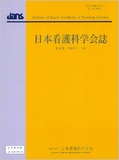Japanese
English
- 販売していません
- Abstract 文献概要
- 参考文献 Reference
要旨
目的:地域在住高齢者の服薬支援の在り方を検討するために,服薬アドヒアランス良群・不良群別に対象者の属性を検討し,2群の服薬管理の工夫の特徴を示した.
方法:地域在住高齢者55名を対象に,属性と服薬アドヒアランスに関する質問紙調査と,服薬管理の工夫に関する聞き取りおよび観察を行った.
結果:服薬アドヒアランス良群は19名(34.5%),不良群は36名(65.5%)であり,全対象者が何らかの服薬管理の工夫を行っていた.【服薬指示理解と服薬の段取り】は〈服薬指示を記憶する〉など13の工夫,【薬の保管】は〈1週間分程の薬を手元に置く〉など10の工夫,【薬の飲み忘れ対策】は〈食事から服薬までを一連の流れで行う〉など9の工夫がされていた.
結論:服薬管理の工夫は,個人の生活に合わせて調整されていた.したがって,看護師は対象者の生活と服薬管理の工夫を把握した上で,服薬支援を行うことが必要である.
Objective: To consider the ideal way to support community-dwelling older adults to take medicine correctly, we compared the attributes of subjects in good and bad medication adherence groups and then analyzed the characteristics of the medication self-management strategies used by these two groups.
Methods: We surveyed 55 community-dwelling older adults with a questionnaire to examine their background and medication adherence. Their medication self-management strategies were identified through observation and interviews.
Results: Of the 55 subjects examined, 19 (34.5%) had good medication adherence, while the remaining 36 (65.5%) had poor adherence. All subjects were found to have devised some form of medication self-management strategies. In the medication instructions and setup, there were 13 medication self-management strategies, such as “memorizing medication instructions”; in medication storage, there were ten strategies, such as “storing medicines scheduled for the week in the place where the person spends most of his or her time”; and in the measures against forgetting timely medicine intake, there were nine strategies, such as “going from eating to taking medicine in a series of steps.”
Conclusions: The self-management strategies were tailored to the individual's daily life. Therefore, it is important to understand one's daily life and medication self-management strategies before providing medication support.
Copyright © 2022, Japan Academy of Nursing Science. All rights reserved.


